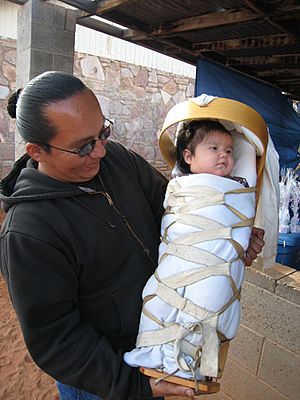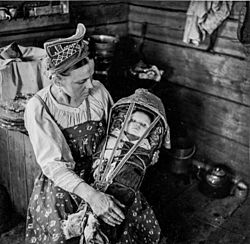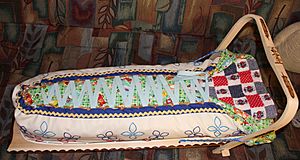Cradleboard facts for kids
Cradleboards are special baby carriers that have been used for a very long time. Many indigenous cultures in North America and the Sámi people in northern Scandinavia traditionally used them. There are many different kinds of cradleboards, showing the unique ways different cultures cared for their babies. Even today, some indigenous communities in North America still use cradleboards for their infants.
Contents
What Are Cradleboards Made Of?
Cradleboards are used during a baby's first few months. They are very helpful when parents need to travel or move around for work. Some cradleboards are woven, like those made by the Apache people. These are often made from strong plant fibers such as willow, dogwood, tule, or cattail.
Other cradleboards are made from wood. The Iroquois and Penobscot peoples are known for making wooden ones. Navajo cradleboards often have a frame made from Ponderosa pine wood. They use buckskin laces woven through the frame to hold it together.
How Cradleboards Are Built
No matter what materials are used, all cradleboards share similar features. They are built with a wide, strong frame that supports the baby's back. This helps keep the infant safe and comfortable.
At the bottom, there's a footrest for the baby's feet. Over the baby's head, there's a rounded cover, like a small canopy. This headpiece gives shade and can be covered with animal skin or a blanket in cold weather. It also protects the baby's head if the cradleboard bumps into something. Often, special decorations or sacred charms are attached to the headpiece. These can include beaded cases or dream catchers. They help keep the baby entertained and can even help their eyesight develop.
Inside the Cradleboard
The inside of a cradleboard is usually padded with soft plant fibers. These can be sphagnum moss, cattail down, or shredded bark from juniper or cliffrose trees. This soft lining acts like a disposable diaper. The Navajo people could even clean and reuse their linings made from shredded juniper or cliffrose bark.
These plant fibers are good for babies because they have natural properties that help keep the skin healthy. The Chippewa people traditionally used moss from cranberry marshes. They would smoke the moss over a fire to kill any insects, then rub it to make it soft. In cold weather, a baby's feet might be wrapped in soft rabbit fur. The moss lining often sat in a removable birch bark tray, which made cleaning easier.
How Cradleboards Were Used
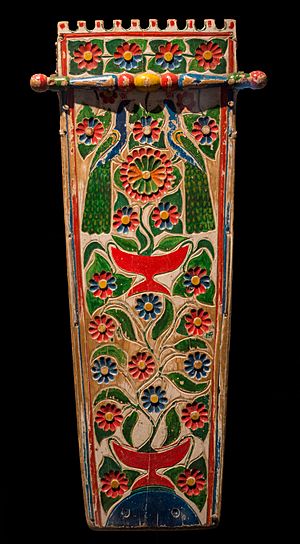

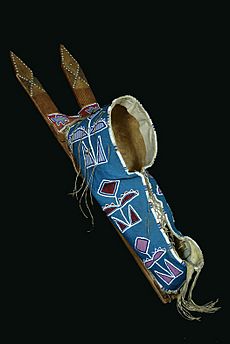
Cradleboards were used by many cultures across a huge area. This ranged from the cold sub-Arctic regions of Canada all the way down to Mexico and Central America. In the very coldest Arctic areas, cradleboards weren't practical. Instead, babies were often carried in a sling under their mother's warm parka.
Cradleboards were common among indigenous people throughout North America. They were also used by the Kickapoo people in Mexico, and historically by the Aztecs and Mayan communities as far south as Belize. In South America, most indigenous cultures used slings or pouches, sometimes called a rebozo, to carry babies. However, cradleboards were used in the southernmost part of the continent, in the Patagonia region.
Carrying and Placement
Cradleboards were especially useful when a mother needed to travel or work. The cradleboard could be carried on her back. Special straps, called "tumplines" or "burden straps," would go around her forehead, chest, or shoulders to support the weight. If she also carried a pack, the pack strap would go around her chest, and the cradleboard strap around her forehead.
Cradleboards could also be placed upright against a large tree or rock. They could be hung from a pole, like inside an Iroquois longhouse, or even from a strong tree branch. For longer journeys, a cradleboard could be attached to a horse for easy transportation.
Daily Use and Growing Up
In the southwest United States and northern Mexico, cultures like the Hopi and Apache used cradleboards for most of the day and night. Babies would be taken out for short periods, up to five times a day. As babies grew and could sit up on their own, they spent less and less time in the cradleboard. Sometimes, a second, larger cradleboard would be used. By the time a baby was about a year old and started walking, they usually stopped using a cradleboard completely.
Studies in Navajo communities have looked at how cradleboard use affects how mothers and babies interact. These studies have shown that using a cradleboard does not harm a baby's development. In their first few months, babies often find cradleboards very soothing. After about six months, babies become more active and might resist being placed in the cradleboard. At this age, their arms and hands are often left free. This allows them to play with objects hung from the cradleboard, which helps keep them entertained.
Images for kids
-
Cradle board being used in the Czech Republic in 2004
See also
 In Spanish: Cuna tablero para niños
In Spanish: Cuna tablero para niños


